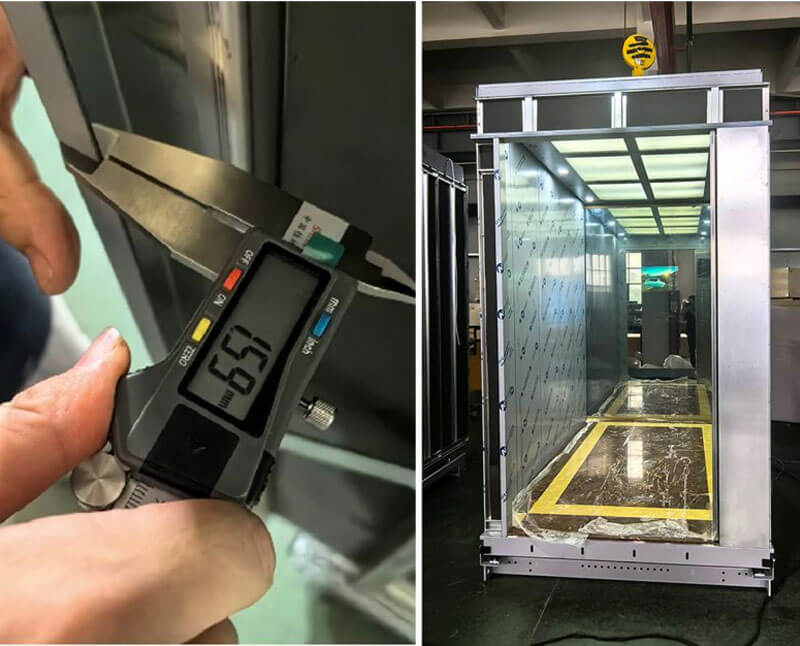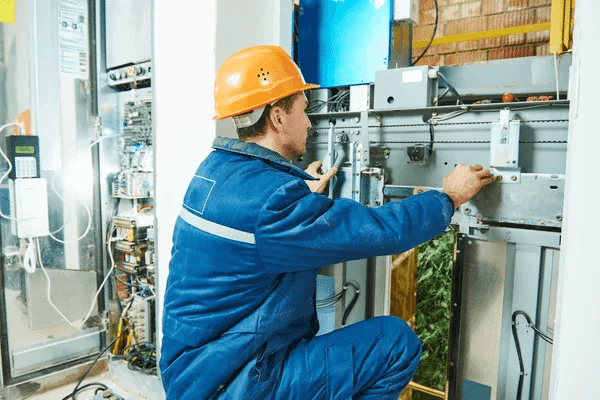Elevator Safety Codes 101
So, what exactly are elevator safety codes? Simply put, they are the rules and standards that manufacturers, installers, and operators must follow to make sure an elevator is safe. These standards cover everything from how elevators should be built, tested, and maintained to how elevators operate in real life. In essence, elevator safety codes provide strict standards for the design, installation, and maintenance of elevators. Although most elevator safety codes date back to only around a century or so, over the years, they have been updated regularly to incorporate new technologies, help promote reliability, and prevent accidents.

History of Elevator Safety Codes
Elevator safety has been a big deal ever since Elisha Otis introduced the first modern elevator with a safety brake back in 1852. This innovation kicked off a whole new era of vertical transportation, which led to today’s detailed safety codes highlighted below:
In Europe, the EN 81 standards popped up in the 1980s to bring elevator safety across different countries under one roof. These codes keep evolving, making sure elevators stay up-to-date with new technology and passenger needs.
Over in the U.S., the ASME A17.1 standard came about in 1921 as cities were growing fast. It has been revised a ton of times to keep up with advancements in mechanical and electrical systems, including new concerns like cybersecurity.
For China, the GB 7588 code was introduced in 1995 to reflect the country’s fast modernization. It aligns with international standards but also integrates cutting-edge safety tech to meet local needs.
In Japan, the JIS A 4301 standard, developed in 1956, is all about earthquake resilience. Given the frequent seismic activity, this code focuses on making sure elevators can handle and keep operating during quakes, with strict testing and advanced safety features.‘
Common Safety Codes Explained
As we have hinted at previously, different regions have developed specific codes to ensure the reliability and security of their elevator systems. It is important to understand these unique regulations, especially if you manage buildings in multiple countries. Let’s explore and break down the standout features and primary regulations of these safety codes in more detail:
EN 81-20 Standards (Europe)
This is Europe’s gold standard for elevator safety. EN 81 series standards are published by CEN (European Committee for Standardization). This set of standards covers pretty much every aspect of elevator safety, from passenger elevators to freight lifts and even accessible elevators for people with disabilities. The European EN 81 series standards include EN 81-20 and EN 81-50, which replaced the older EN 81-1 and EN 81-2 codes that had been around since 1998. As of August 31, 2017, all elevators in use anywhere in Europe need to comply with these updated standards. These newer codes bring major improvements in both accessibility and safety—not just for passengers but also for service technicians. EN 81-20:2014 covers all the updated safety requirements for building and installing elevators, while EN 81-50:2014 lays out the rules for testing and examining specific elevator components.
Unique Features and Scope:
The scope of the EN 81-20 Series Standards is quite comprehensive. It covers all types of elevators, including passenger and freight, with particular specifications for various environments such as residential, industrial, and hazardous areas. Some key sections include:
- Part 20: covers safety rules for the construction and installation of lifts for the transport of persons and goods, ensuring that elevators are designed and installed to minimize safety risks.
- Part 70: covers accessibility to lifts, including lifts for persons with disabilities,
- Part 73: covers the behavior of lifts in the event of fire and lays out emergency preparedness features and guidelines.
The EN81 Series Standards undergo regular updates to incorporate the latest technological advancements and safety improvements. For instance, recent updates have focused on energy efficiency and the integration of smart technologies for predictive elevator maintenance. A standout feature is that EN 81-20 specifically addresses features to assist people with disabilities through enhanced touch and sound signals.
Primarily, the EN 81 Series regulates mechanical and electrical safety, ensuring sturdy elevator design and reliable installation. These standards also emphasize stringent maintenance protocols and periodic inspections by designated regulatory authorities, guaranteeing that elevators stay safe and compliant over time.
At Dazen Elevator, we ensure that every one of our elevators that serves European markets meets these stringent standards. Please take a look at how we implemented the EN81-20 standard.

ASME A17.1 (USA)
If you’re in the United States, the safety code you need to follow is ASME A17.1. This standard, developed by the American Society of Mechanical Engineers, is used across North America. The ASME elevator safety codes set a standard in the industry to minimize accidents and injuries, as well as costly downtime. These standards also seek to provide consistency in elevator construction and installation across North America. The code covers everything from the mechanical design of elevators to their maintenance and inspection. It also contains detailed sections on emergency operations, such as handling power outages and trapped passengers, as well as accessibility standards for passengers with disabilities.
Unique Features and Scope
Across the US, the ASME A17.1 code is well-known for its detailed focus on safety mechanisms, such as emergency brakes and backup power systems, ensuring the highest safety levels for all elevator users. Widely adopted across different states with regional enhancements, the latest versions of ASME A17.1 have integrated cybersecurity measures to protect against potential threats to elevator control systems. ASME A17.1 also underscores the importance of maintenance and operational protocols, particularly emphasizing the need for safe elevator operations during emergencies like fires or power failures. Some critical sections include:
- Section 2 covers the construction of elevators, focusing on both the construction of elevators and the installation of crucial safety features.
- Section 8 relates to inspections and tests and outlines the requirements for regular maintenance to ensure the safety and reliability of elevators and
- Section 14, which specifies standards for emergency operations by establishing procedures for the operation of elevators during emergencies, including power failures and fires.
Recent updates to the ASME A17.1 codes introduced some important changes to how car emergency signaling devices work. Now, elevators are required to have a two-way message display inside the cab for anyone who’s hearing or speech impaired. There’s also a new rule that allows emergency personnel to view video footage of passengers in the elevator and, if necessary, change the display to let everyone know that help is on-site—especially if the elevator has traveled over 60 feet.
These updates are designed to make emergencies safer and less stressful, particularly for those who are deaf, hard of hearing, or have speech impairments. Emergency teams can assess what’s happening inside the cab via a camera, and they can communicate non-verbally with passengers. Cool, right? The updated code also outlines what equipment is needed to comply with these new changes. If you’re a building owner in the U.S., compliance with ASME A17.1 is crucial to avoid fines and legal sanctions.

GB 7588 (China)
GB 7588 is China’s national elevator safety standard, and it’s a rigorous one. This set of rules mirrors many of the safety requirements found in European and American standards, with a focus on local conditions and regulations. It lays out the safety rules for building and installing electric lifts—whether they’re for passengers, sickbeds, or cargo—with the goal of keeping passengers safe from injury and preventing any damage to cargo while the lifts are in operation. The GB 7588 also covers electric passenger lifts, sickbed lifts, and cargo lifts that use traction or positive drive systems, as well as lifts for miscellaneous items and hydraulic lifts.
Unique Features and Scope
The GB 7588 code addresses the specific needs and safety concerns of the region through localized regulations. Aligning well with global elevator safety standards and addressing unique Chinese construction practices and materials, this code is frequently revised to incorporate the latest safety technologies. It focuses heavily on safety features like brakes, emergency stop mechanisms, and overload protection. It also has strict guidelines for regular maintenance and inspections. Some key sections include:
- Chapter 5 covers the design of elevators, ensuring that elevators are designed with safety as a paramount concern while integrating advanced technology.
- Chapter 9 lays out important safety devices and features, mandating exhaustive testing and regular inspections to identify and address safety concerns.
- Chapter 12 establishes safe and thorough testing, operational safety, and regular inspection protocols, as well as emergency preparedness.
Recent updates to GB 7588 include advanced sensor technologies for real-time monitoring of elevator conditions and AI-driven diagnostics for predictive maintenance. In general, the GB 7588 emphasizes safety and reliability in the design and installation of elevators while prioritizing thorough testing and regular inspections.
Here at Dazen Elevator, this is the big one for us, even though our elevators are used all over the world. Since Dazen Elevator is based in China, adhering to GB 7588 is part of what we do best. Whether we’re working on residential, commercial, or industrial projects, we follow this code to the letter.

JIS A 4301 (Japan)
Finally, let’s head to Japan. The JIS A 4301 standard is Japan’s contribution to the world of elevator safety. Known for its precision, it’s no surprise that Japan’s elevator standards are among the strictest in the world. The Japanese codes focus on the mechanical and electrical design of elevators. They also have extensive testing protocols to ensure continued safety.
Unique features and scope
The JIS A 4301 code has some unique features that set it apart from other standards. Given Japan’s location in a seismically active region, earthquake resilience is a top priority. Elevators in Japan must be designed to withstand tremors, and special systems are in place to stop the elevator at the nearest floor during an earthquake, ensuring passenger safety. Recent updates to the JIS A 4301 code have also included advanced damping systems and enhanced structural integrity requirements to better withstand earthquakes. This code also includes cutting-edge technologies for safety and efficiency, such as IoT-enabled remote monitoring systems that provide real-time data on elevator performance.
Japanese standards like JIS A 4301 can be obtained from the Japan Industrial Standards Committee (JISC). Some of the more important sections include:
- Section 3, which covers seismic safety provisions, including detailed guidelines to ensure elevator safety in the event of earthquakes.
- Section 6, which details advanced safety devices and operational features. It also outlines the technology for the specified safety devices and operational features.
- Section 11, which lays out the regulations guiding regular maintenance and inspection routines to maintain optimal elevator functionality and safety.
The JIS A 4301 takes note of the unique building designs and materials typical in Japan, ensuring that the standards are culturally and practically appropriate. It also mandates regular maintenance checks and comprehensive inspection routines to maintain optimal safety and functionality. This attention to detail makes Japanese elevators some of the safest and most reliable in the world.

Why Are Elevator Safety Codes So Important?
Whether you’re a building owner, a property manager, or just someone who uses elevators every day, these safety codes are what’s keeping you safe once you get into one. If an elevator doesn’t meet the required safety standards, it becomes a potential hazard, leading to everything from minor inconveniences to serious accidents and even deaths. As a property owner, if your building is inspected and your elevators do not meet the area requirements, you will be asked to ensure compliance or face heavy fines because, let’s face it, you could be putting lives at stake if safety standards are compromised. At Ascensor Dazen, these codes are our blueprint. We not only comply with China’s GB 7588 but also the EN 81 standards for our European clients. Safety isn’t something we take lightly—it’s at the core of everything we do.
ticking to elevator safety codes isn’t just about following rules. Let’s summarize the reasons why these codes are so essential:
Passenger Safety and Confidence
First and foremost, elevator codes exist to protect passengers. When elevator safety codes and standards are followed, malfunctions become less frequent, and even if something does go wrong, there are built-in safety features like emergency buttons to get help quickly. Passengers also feel more confident and secure in elevators that are regularly inspected and maintained according to code so they can ride without worrying about unexpected malfunctions.
Standardization Across the Industry
Elevator codes also make life easier by standardizing how elevators are built and maintained. No matter where you are in the world, you’re likely dealing with similar systems, making maintenance and part replacement simpler and more efficient.
Legal Compliance
Cutting corners on safety codes isn’t just risky—it can lead to severe legal issues. Ensuring compliance with national regulations prevents dangerous situations and keeps building owners on the right side of the law.
Saving Costs
Lastly, following elevator safety codes can actually save you money. Elevators that meet required standards tend to have fewer breakdowns and longer lifespans, meaning lower repair costs over time and fewer headaches from emergency maintenance or lawsuits.
Conclusión
Elevators play such an important role in our daily lives, so safety is key. Whether you’re stepping into a lift in London, Brussels, Beijing, New York, or Paris, there’s a safety code behind it, making sure you get to your destination safely. For those working with multiple safety standards, understanding the main regulatory functions and accessing relevant sections of each safety code can significantly aid in ensuring compliance and elevating safety standards across different regions.
En Ascensor Dazen, we pride ourselves on adhering to the strictest safety standards, whether it’s GB 7588 in China or EN 81-20/50 in Europe. Next time you ride in an elevator, especially if it is one of ours, you can rest easy knowing that you’re in safe hands.
